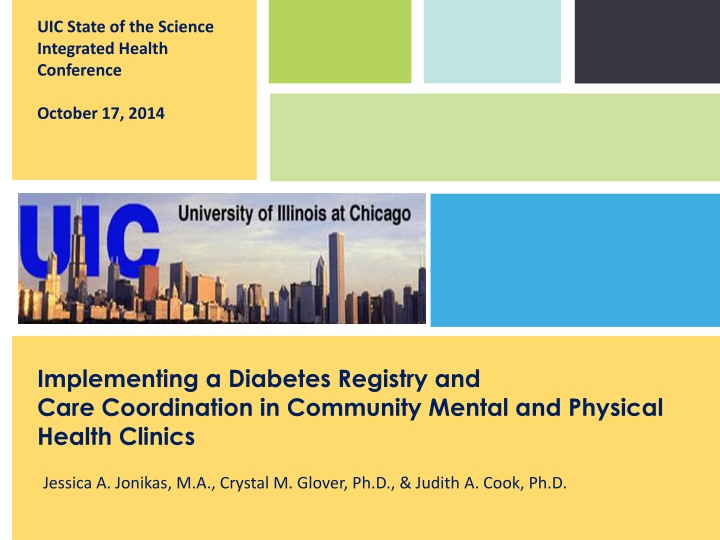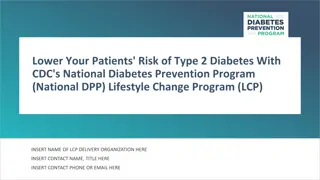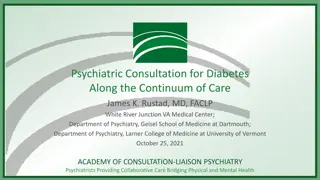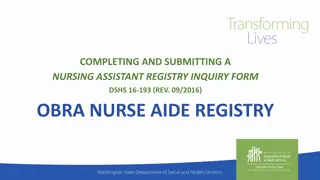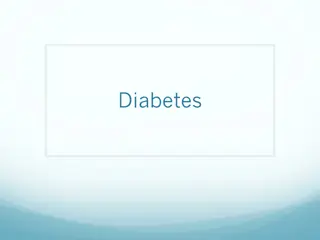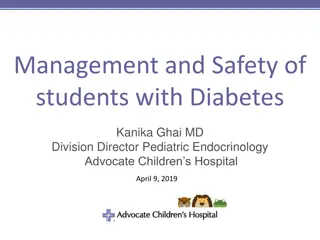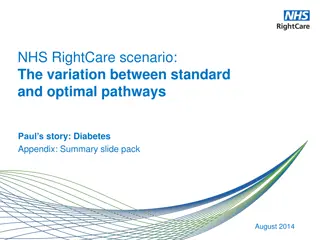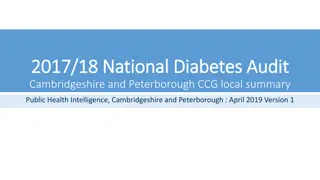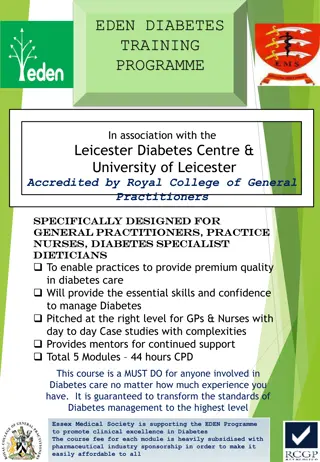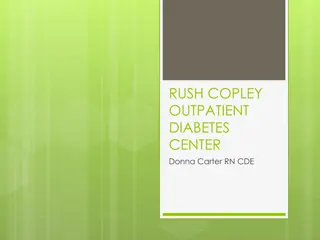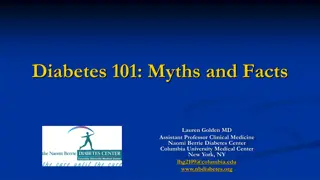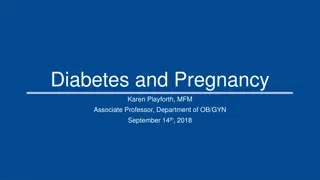Implementing a Diabetes Registry and Care Coordination
People with diabetes are at risk for several health issues, and those in recovery face even more challenges. This presentation discusses the importance of implementing a diabetes registry and care coordination in community mental and physical health clinics. The focus is on addressing the public health crisis posed by diabetes, exploring the benefits and evidence of using registries, and considering key barriers and next steps in diabetes care coordination.
Download Presentation

Please find below an Image/Link to download the presentation.
The content on the website is provided AS IS for your information and personal use only. It may not be sold, licensed, or shared on other websites without obtaining consent from the author.If you encounter any issues during the download, it is possible that the publisher has removed the file from their server.
You are allowed to download the files provided on this website for personal or commercial use, subject to the condition that they are used lawfully. All files are the property of their respective owners.
The content on the website is provided AS IS for your information and personal use only. It may not be sold, licensed, or shared on other websites without obtaining consent from the author.
E N D
Presentation Transcript
UIC State of the Science Integrated Health Conference October 17, 2014 Implementing a Diabetes Registry and Care Coordination in Community Mental and Physical Health Clinics Jessica A. Jonikas, M.A., Crystal M. Glover, Ph.D., & Judith A. Cook, Ph.D. Jonikas, Glover, & Cook, 2014 www.cmhsrp.uic.edu/health/
Todays Presentation Diabetes as a public health crisis UIC Diabetes Care Coordination & Registry Study The case for registries: benefits and evidence Using a registry to support population management and self- management Preliminary results from our study Considering key barriers Reflections on next steps Jonikas, Glover, & Cook, 2014 Jonikas, Glover, & Cook, 2014 www.cmhsrp.uic.edu/health/index.asp www.cmhsrp.uic.edu/health/
With thanks to our funders U.S. Department of Education, National Institute on Disability & Rehabilitation Research Substance Abuse & Mental Health Services Administration, Center for Mental Health Services Cooperative Agreement #H133G100028 Jonikas, Glover, & Cook, 2014 www.cmhsrp.uic.edu/health/
Registry & Care Coordination Collaborators UIC Center on Psychiatric Disability & Co- Occurring Medical Conditions UIC College of Nursing, Integrated Health Care Clinics Thresholds Psychiatric Rehabilitation Centers UIC Eye & Ear Infirmary & Dr. LaVallee Kennedy-King College s Dental Hygiene Department Dr. Robert Laveau at UIC Podiatry Clinic Jonikas, Glover, & Cook, 2014 Jonikas, Glover, & Cook, 2014 www.cmhsrp.uic.edu/health/index.asp www.cmhsrp.uic.edu/health/
Key Study Partners Sue Braun Emily Brigell Kathy Christiansen Kristin Davis Katy Dobbins Jay Forman Ann Heesacker Asma Jami Sheila O Neill Deborah Pavick Pam Steigman Joni Weidenaar Jonikas, Glover, & Cook, 2014 Jonikas, Glover, & Cook, 2014 www.cmhsrp.uic.edu/health/index.asp www.cmhsrp.uic.edu/health/
A Public Health Crisis People with diabetes are at-risk for developing: People in recovery have a higher prevalence of diabetes: Hypertension Hyperlipidemia Heart disease Kidney disease Gum disease/loss of teeth Nerve damage/loss of feet Eye disease/becoming blind Costs are 2.4 times greater; nearly 40% of costs due to long-term complications. Lifestyle factors Psychiatric medications that cause blood sugar disorders Complicated illness - doctors & patients often unsure of what s behind poorly controlled glucose Jonikas, Glover, & Cook, 2014 www.cmhsrp.uic.edu/health/
Use of a Registry to Manage Care for Diabetes in Integrated Health Clinics for Adults with Serious Mental Illnesses Judith A. Cook, PhD, Principal Investigator Introduce a diabetes registry to: 1. Improve care delivery full adherence to ADA standards of care develop new treatment & service resources 2. Enrich care coordination link clients to needed specialty care in accordance with ADA standards teach clients about diabetes and its complications 3. Better monitor health indicators and outcomes over time Free Diabetes Toolkit Jonikas, Glover, & Cook, 2014 Jonikas, Glover, & Cook, 2014 www.cmhsrp.uic.edu/health/index.asp http://www.cmhsrp.uic.edu/health /diabetes-library-home.asp www.cmhsrp.uic.edu/health/
What is a Diabetes Registry? Database with demographics, illness characteristics, treatment delivered, and specialty care arranged/delivered Generates charts and graphs to support illness self- management Generates reports to monitor team and system performance Information from electronic and paper records guides care, tracks outcomes, and informs plans for improving care Overall goal is to improve adherence to treatment guidelines and self- management Supports proactive care by facilitating care planning, sharing of information with other providers, and generating patient reminders Jonikas, Glover, & Cook, 2014 www.cmhsrp.uic.edu/health/
Sample Standards Tracked in Diabetes Registries for Individual & Population Management Standard Target Blood Glucose Control (HbA1c) Less than 7% Blood Pressure Less Than 140/90 mmHg LDL cholesterol Less Than 100 mg/dl Urine Screening for Microalbumin Annual screening Dilated eye exam Annual screening Foot exam for neuropathy Annual screening Dental exam Annual screening Vaccinations Lifetime and annual Jonikas, Glover, & Cook, 2014 Jonikas, Glover, & Cook, 2014 www.cmhsrp.uic.edu/health/index.asp www.cmhsrp.uic.edu/health/
How are data entered? Different options depending on resources: 1. Clinicians enter data manually themselves during or after visits 2. Clinicians complete diabetes encounter forms, which are sent to a central site for data entry that is supported by a registry project 3. Care coordinators obtain information for the registry from patient records after each visit 4. Clinicians complete diabetes encounter forms, which are given to the Care Coordinator to enter into the registry Jonikas, Glover, & Cook, 2014 Jonikas, Glover, & Cook, 2014 www.cmhsrp.uic.edu/health/index.asp www.cmhsrp.uic.edu/health/
Why Registries for Standards of Care? One electronic database contains data from multiple sources to inform complex disease processes Quickly focuses effort on better managing chronic disease at population level Can be used by multiple parties (clinicians, patients, administrators) to facilitate care delivery while meeting care standards (Ortiz, 2006) Jonikas, Glover, & Cook, 2014 www.cmhsrp.uic.edu/health/
Registries and Patient-Centered Care Helps clients track their own results over time, assess personal improvements, and identify areas of concern Allows clients to see their test results related to 1 or more conditions all in one place Permits clients to share current results with specialists and other providers for safer/better care coordination and outcomes Enables clients to compare their test results and health outcomes with those of peers or the general population Jonikas, Glover, & Cook, 2014 www.cmhsrp.uic.edu/health/
Why Registries for Care Coordination? Allows for identification and monitoring of clients with a specific need within a clinic or across clinics Promotes use of evidence- based and values-driven care Puts the focus on the needs and progress of high-risk clients to manage limited resources (client & clinic) Fosters individual disease management through notifications of abnormal test results, missed appointments, and up-to- date information on client encounters Facilitates health outcomes management at both the individual and clinic levels (Hummel, 2000) Jonikas, Glover, & Cook, 2014 www.cmhsrp.uic.edu/health/
Population Studies using a Diabetes Registry Improving Diabetes Care in a Large Health Care System: An Enhanced Primary Care Approach Sperl-Hillen, et al. (2000). Joint Commission Journal on Quality and Patient Safety Improved glycemic and lipid control among approximately 7,000 adults with diabetes. The Impact of Planned Care and a Diabetes Electronic Management System on Community-Based Diabetes Care: The Mayo Health System Diabetes Translation Project Montori et al. (2002). Diabetes Care. Registry use augmented the impact of planned care on performance outcomes (increased use of specialty medical care) and certain metabolic outcomes. Did not impact glucose levels. Jonikas, Glover, & Cook, 2014 Jonikas, Glover, & Cook, 2014 www.cmhsrp.uic.edu/health/index.asp www.cmhsrp.uic.edu/health/
Diabetes Registries: Across Clinics Improving Diabetes Outcomes Using a Web-Based Registry and Interactive Education: A Multisite Collaborative Approach Morrow, R. et al., (2013). Journal of Continuing Education in the Health Professions Electronic diabetes registry in 7 clinics in NY With educational module on the registry and patient communication With each quarter post-Registry, patients were: 1.4 times more likely to have A1C 9 Almost twice as likely to have LDL < 100 1.3 times more likely to have BP < 140/90 Likelihood of adherence increased over the initial quarters (except for BP; adherence dipped over time). There was a drop-off among all indicators after 5 quarters, suggesting ongoing support and training are needed Jonikas, Glover, & Cook, 2014 Jonikas, Glover, & Cook, 2014 www.cmhsrp.uic.edu/health/index.asp www.cmhsrp.uic.edu/health/
Okay, but why not just use an Electronic Health Record? Most EHRs are not built to function as registries, so can t support population-based care It can take years for population reporting from an EHR A registry is relatively easy and inexpensive Can have nearly immediate impact on clinic practice and client engagement & outcomes It can be instructive to learn population-based care parameters prior to implementing an EHR via a registry Allows you to design EHR processes to support needs identified by registry use Content adapted from: www.powershow.com/view/21d14- MzEyZ/Using_Excel_for_a_HgA1c_Registry_powerpoint_ppt_presentation Jonikas, Glover, & Cook, 2014 Jonikas, Glover, & Cook, 2014 www.cmhsrp.uic.edu/health/index.asp www.cmhsrp.uic.edu/health/
Platform Options CareMeasures www.caremeasures.org/CareMeasur es/public/Default.aspx Easy to use & customize Manages multiple conditions Must register & pay fees CDEMS cdems.com Relational database Challenging to learn and implement Technical support no longer available Excel http://www.aafp.org/fpm/2006/0400/ p47.html Free software and template Easy to learn and implement - Storing only the most recent results Good for population management of single disease Doc Site portal.covisint.com/web/supporthc /ccahc Web-based; easy to access Can role up nationally Annual per provider fee Content adapted from: www.powershow.com/view/21d14- MzEyZ/Using_Excel_for_a_HgA1c_Registry_powerpoin t_ppt_presentation Jonikas, Glover, & Cook, 2014 www.cmhsrp.uic.edu/health/
Jonikas, Glover, & Cook, 2014 Jonikas, Glover, & Cook, 2014 www.cmhsrp.uic.edu/health/index.asp www.cmhsrp.uic.edu/health/ www.aafp.org/fpm/2006/0400/p47.html
Population Management via Reports Client Last Name Client Birthdate Provider Value of most recent A1C Date of most recent A1C Ryan 03/31/40 9.8 09/05/2014 Sort by test value to determine who is most at risk Bell 05/25/72 8.9 02/18/2013 Cruz 06/16/60 7.8 06/17/2013 Smith 01/15/65 7.1 08/15/2014 Ramirez 05/24/61 6.5 08/01/2013 Jordan 09/12/60 6.5 09/12/2013 Stock 10/10/80 6.2 07/13/2014 Blake 12/12/40 5.2 05/14/2014 Bergman 11/12/61 5.0 05/05/2014 Registry Reports from a Simple Microsoft Excel-based Registry Jonikas, Glover, & Cook, 2014 Jonikas, Glover, & Cook, 2014 www.cmhsrp.uic.edu/health/index.asp www.cmhsrp.uic.edu/health/
Care Coordination via Reports Client Last Name Client Birthdate Provider Date of most recent eye exam Bell 05/25/72 11/11/2011 Sort by test date to determine who is overdue and needs care coordination Cruz 06/16/60 06/10/2012 Ramirez 05/24/61 04/15/2013 Jordan 09/12/60 02/17/2013 Smith 01/15/65 10/16/2013 Ryan 03/31/40 10/17/2013 Stock 10/10/80 04/13/2014 Bergman 11/12/61 03/05/2014 Blake 12/12/40 02/14/2014 Registry Reports from a Simple Microsoft Excel-based Registry Jonikas, Glover, & Cook, 2014 Jonikas, Glover, & Cook, 2014 www.cmhsrp.uic.edu/health/index.asp www.cmhsrp.uic.edu/health/
Performance Management via Reports Client Last Name Client Birthdate Provider Value of most recent A1C Date of most recent A1C Ryan 03/31/40 Dr. S 9.8 09/05/2013 Sort by provider then value to identify performance goals Smith 01/15/65 Dr. S 7.1 08/15/2014 Ramirez 05/24/61 Dr. S 6.5 08/14/2014 Jordan 09/12/60 Dr. S 6.5 08/17/2014 Bell 05/25/72 Dr. A 8.9 02/18/2014 Cruz 06/16/60 Dr. A 7.8 06/17/2013 Stock 10/10/80 Dr. A 6.2 08/17/2014 Blake 12/12/40 Dr. A 5.2 09/14/2014 Bergman 11/12/61 Dr. A 5.0 09/05/2014 Registry Reports from a Simple Microsoft Excel-based Registry Jonikas, Glover, & Cook, 2014 Jonikas, Glover, & Cook, 2014 www.cmhsrp.uic.edu/health/index.asp www.cmhsrp.uic.edu/health/
The Purpose of Our Registry Introduced to: Fully adhere to ADA standards of care by improving care delivery and coordination Link participants to specialty care in accordance with ADA standards Teach participants about diabetes and its complications Develop new treatment/service resources Monitor health indicators and outcomes over time Jonikas, Glover, & Cook, 2014 Jonikas, Glover, & Cook, 2014 www.cmhsrp.uic.edu/health/index.asp www.cmhsrp.uic.edu/health/
The Collaboration UIC College of Nursingstaff operate the nurse-managed Integrated Health Clinics (IHCs) where study participants received medical care. At the time the initial study sample was drawn, the IHCs were serving 220 patients with co-occurring diabetes & mental illness. Thresholdshouses one IHC on Chicago s north-side and one on Chicago s south-side. Thresholds provided community support and linkage to Registry clients to help them attend the IHCs and specialty appointments, and to self-manage their co-occurring conditions. UIC Center on Psychiatric Disability and Co-Occurring Medical Conditions staff built the registry which was populated with data on the 220 patients; the UIC Center funded the study s Care Coordinator who liaisoned with IHC and Thresholds staff, focusing specifically on increasing adherence to diabetes care standards. Jonikas, Glover, & Cook, 2014 Jonikas, Glover, & Cook, 2014 www.cmhsrp.uic.edu/health/index.asp www.cmhsrp.uic.edu/health/
A Tour of our Registry Chronic Disease Electronic Management System (CDEMS) platform o A relational database with demographic information, illness characteristics, treatment delivered, and specialty care arranged and delivered o Baseline data derived from 2011 IHC visits, with updates made each time a patient received treatment, including nurse visits, laboratory work, patient education, and/or specialty care o Generated patient- and clinic-level reports o Reports allowed for tracking of clinic-wide adherence to American Diabetes Association standards of care, as well as monitoring patients diabetes-related needs and outcomes o Jonikas, Glover, & Cook, 2014 Jonikas, Glover, & Cook, 2014 www.cmhsrp.uic.edu/health/index.asp www.cmhsrp.uic.edu/health/
Registry & Coordination Procedures to Impact on Outcomes Patient-specific reports from the registry were provided to nurses prior to each patient visit helped orient them to the most recent treatment(s), upcoming tests or appointments, and the most pressing concerns Patient education materials were also shared with community support workers to reinforce this learning in the community Specialty care needs were identified for each patient Support given for each client to see specialists, in accordance with the ADA standards of care (including optometrist, dentist, and podiatrist) Patient education was chosen from comprehensive materials to address each patient s specific needs and strengths at each visit Jonikas, Glover, & Cook, 2014 www.cmhsrp.uic.edu/health/
Sample Patient Specific Registry Report Jonikas, Glover, & Cook, 2014 Jonikas, Glover, & Cook, 2014 www.cmhsrp.uic.edu/health/index.asp www.cmhsrp.uic.edu/health/
Sample Patient Report Designed for Education & Self-Management Jonikas, Glover, & Cook, 2014 Jonikas, Glover, & Cook, 2014 www.cmhsrp.uic.edu/health/index.asp www.cmhsrp.uic.edu/health/
Sample Patient Education Jonikas, Glover, & Cook, 2014 www.cmhsrp.uic.edu/health/
Registry Study Sample (n = 217) 67% male 2/3 members of racial/ethnic groups: 60% African American; 27% White; 4% Hispanic/Latino; 2% Asian; 7% Other Age range: 20 to 77 years (mean=51; sd.=10) 54% were patients at the north-side clinic 46% were patients at the south-side clinic Jonikas, Glover, & Cook, 2014 Jonikas, Glover, & Cook, 2014 www.cmhsrp.uic.edu/health/index.asp www.cmhsrp.uic.edu/health/
Preliminary Medical Outcomes Changes in glucose management following introduction of the Registry and Care Coordination: The least controlled (i.e., poorest) A1c level during the pre-test years of 2010-2012 (N=205) averaged 7.97 per patient A1c at the most recent visit during the post-test years of 2013-2014 (N=201) averaged 6.93 per patient In other words, there was significant improvement from poorest to most recent A1c, decreasing by 1 point on average (t=5.08, p<.001). Every 1% improvement in A1c is associated with a 25% decrease in a combined index of cardiovascular complications for people with type 2 diabetes (UK Prospective Diabetes Study Group, 1998). Jonikas, Glover, & Cook, 2014 Jonikas, Glover, & Cook, 2014 www.cmhsrp.uic.edu/health/index.asp www.cmhsrp.uic.edu/health/
Preliminary Medical Outcomes Changes in total cholesterol and triglycerides following introduction of the Registry and Care Coordination: Worst total cholesterol (TC) during the pre-test years (N=197) averaged 180 mg/dL per patient, while the average at post-test was 165 mg/dL (N=170) (t=3.5, p<.001) Worst triglycerides level in pre-test years averaged 165 mg/dL per patient (n=198), while the average at post-test was 143 mg/dL (N=169) (t=2.2, p<.05) The average TC and triglycerides showed significant improvement, with lipids and triglycerides dropping by 27 or more points. Jonikas, Glover, & Cook, 2014 Jonikas, Glover, & Cook, 2014 www.cmhsrp.uic.edu/health/index.asp www.cmhsrp.uic.edu/health/
Preliminary Specialty Care Outcomes Changes in adherence to the ADA standards of care following introduction of the Registry and Care Coordination: Between 2010-2012, completed dental referrals had a percentage increase of 500% 2.8% at pre-test, 16.6% at post-test ( 2 = 23.74, p < 0.001) Between 2010-2012, completed optometry referrals had a percentage increase of 65% 21% at pre-test, 35% at post-test ( 2 = 10.1, p < 0.01) Between 2010-2012, completed podiatry referrals had a percentage increase of 88% 15% at pre-test, 28% at post-test ( 2 = 11.3, p < 0.01) Jonikas, Glover, & Cook, 2014 Jonikas, Glover, & Cook, 2014 www.cmhsrp.uic.edu/health/index.asp www.cmhsrp.uic.edu/health/
Key Barriers to Registry Use Shifting from reaction to prevention Time to load and maintain the spreadsheet or database Moving from individual level to population-based care Measuring performance can be threatening Getting multiple partners invested Just another fad? Content adapted from: www.powershow.com/view/21d14- MzEyZ/Using_Excel_for_a_HgA1c_Registry_powerpoint_ppt_presentation Jonikas, Glover, & Cook, 2014 www.cmhsrp.uic.edu/health/
Reflections and Next Steps Registries, especially those in a simple Excel format, can quickly focus attention on the needs of those clients who most require integrated and coordinated care efforts The role of the behavioral health case manager/support worker is expanding to require expertise in medical management and medical care coordination Integrated patient education, health literacy, and self- management are critical promotion and prevention approaches Front-line and supervisory staff also benefit from employee health and wellness programs Jonikas, Glover, & Cook, 2014 Jonikas, Glover, & Cook, 2014 www.cmhsrp.uic.edu/health/index.asp www.cmhsrp.uic.edu/health/
Learn about our registry study www.cmhsrp.uic.edu/health/medical_home_re gistry.asp Free Diabetes Toolkit http://www.cmhsrp.uic.edu/health/diab etes-library-home.asp Jonikas, Glover, & Cook, 2014 www.cmhsrp.uic.edu/health/
